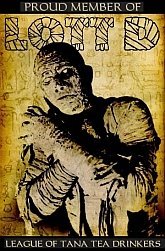 Zombos Says: Good (in spite of the found footage POV inconsistencies and inaccuracies)
Zombos Says: Good (in spite of the found footage POV inconsistencies and inaccuracies)
I was expecting a larger scale of military engagment from director Richard Raaphorst for Frankenstein’s Army, but he and his scripters (Chris W. Mitchell and Miguel Tejada-Flores) create strong dieselpunk and art house aesthetics with a haunt attraction’s worth of frenzied creature-fest chills. Madcap amalgams of mech and flesh kill anything and everything within striking distance with their propeller heads, long drill-bit snouts, and skull crushing claws.
I wasn’t expecting the gimmicky found footage approach. Even if Raaphorst and cinematographer Bart Beekman know how to exploit it for all it’s worth with clever POV positionings and digitally mottling the "film" to show Frankenstein’s grandson Viktor's (Karel Roden) sadistic megalomania and perverse family skills with dead body parts (or living ones). With a Hammer-styled blood infusion of pacing and cinematography (I'd also add a touch of Amicus) and a Hostel and Saw-liberated gory relish, and even maybe a Fulci's sensibility for crazy deep-dish body-zombie-horror, the use of a wind up motorized handheld camera interferes as it goes well beyond what would have been possible with such technology available during World War II. Ignore the fancy but impossible use of the camera and you have an artsy-trashy Octoberfest delirium dressed with exposed brains and sudden deaths that is compellingly and intentionally awful; don't ignore the found footage inaccuracies and inconsistencies with the then level of technology and you are left with only an artsy-trashy misconception filled with nightmarish haunt-attraction worthy monsters doing serious body damage to anyone unlucky enough to cross paths with them.
The unlucky ones include the Russian soldiers, whose unsavory character traits are given as such to alleviate our concern over their eventual splattery dispatch, or Raaphorst is making a political statement but it's lost in the helter skelter. In either case, cracking open the skull of one unfortunate individual--which is as upsetting to watch as it is for the poor bastard to experience--to remove a hemisphere's worth of gray matter from his head, and then chop around the edges to make what remains fit with another person's other brain half, is effectively over the top (or off the top, to be more precise). Watching this movie is like re-experiencing the tacky excesses of the Video Nasties from another decade, but done here with more verve for shock value to compensate for our jadedness.
And it does work to a good degree.
Horror can be most memorably terrifying and perversely exhilarating when it assaults our sense of propriety or dares to insult our intelligence with clever but contrived artifice. Frankenstein's Army does both, which makes for great critical analysis on the one hand, and great criticism on the other. At its center is a highly creative and well executed terror movie for those who like their horror served raw on the plate without garnish. Story elements are minimal, focusing on the Russian soldiers being filmed for propaganda and archival purposes as they travel through enemy territory to find supposed comrades held captive by the Nazis. It's toward the end of the war and the Nazis are in retreat. Except for Viktor. He's following Henry Ford's assembly line process to create undead zombie robot (zombot) soldiers: Mr. Potato Head assemblages of men, spare body parts, and whatever machinery or tools are at hand. Once assembled they roam around, killing anyone they come across. Whatever Viktor's purpose was originally, clearly his insanity has reassembled it, too.
Slowly the Russians come across the remains of Viktor's surgical skills. For a spring powered camera it runs for a noticeably long time without needing rewinding. Held by Dimitri (Alexander Mercury) it never falters to record everything, stretching our credulity as does every POV found footage movie since The Blair Witch Project. A failed zombot hooked up to a generator eviscerates one soldier, signaling the stalk and skewer phase of the story. Another zombot with a crushing propensity leads to a grossly funny helmet removal as more than the helmet is accidentally removed. Each zombot appearance is more outrageous than the other, and the terminal visit to Viktor's fright-assembly factory reveals more secrets and more horrors.
Given a larger budget, grander scale of Allied military carnage, and a lighter, more mainstreamy tone shot with conventional camerawork, Frankenstein's Army could have won over a larger audience. But there is no nostalgia here or matinee popcorn to be served. The Andrews Sisters do not perform their musical interlude of Boogie Woogie Bugle Boy, and no U.S. Commandos come to the rescue.
But the zombots and Viktor's crazy behavior make up for what's missing, at least for those horror fans who don't cover their eyes when it gets messy and who aren't enamored of subtle terrors and highbrow storylines.













